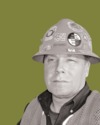
Life as a Boy Scout, lashing ropes and tying knots, may have inspired Mike Parnell to enter the dangerous world of lifting and rigging. In his 34 years working in the skilled trade, Parnell has gained a following as a consensus-builder among industry groups that aim to raise the bar on crane safety.
As chairman of the ASME P30 lift-planning committee—which last month drafted the industry's first-ever standard for how to plan a lift—Parnell, 56, wanted to help employers make better decisions whenever they move heavy objects.
 |
| PARNELL |
"It was something that the industry was asking for," says Michael W. Mills, a specialist at Liberty Mutual in Louisville, Ky., and P30 vice chairman. In 2008—a year of high-profile crane accidents—Mills saw the need for such a document. He approached Parnell and Bradley D. Closson, president of CRAFT Forensic Services in Bonita, Calif., for help. They took the cause to the American Society of Mechanical Engineers B30 crane-standards committee, which declined to get involved. The trio then applied to ASME to form a new committee. As committee chairman, Parnell assembled a diverse group of about 30 lifting experts, including Mills and Closson, who began meeting and writing in 2010.
Accident studies indicate that safe lifting begins with good planning, yet no standard or regulation governing lift plans has existed until now. "It's typically an on-the-fly decision that brings the house down," says Parnell, who is president of Industrial Training International Inc.
The P30 document is simple. It is about 30 pages long and contains no technical diagrams. However, it walks users through a decision tree of important safety factors and considerations. Released for public comment in December, the final document is expected to become available later this year through ASME's standards library.
"This is a cookbook," Closson says. "If you use these elements in your own mixture—for your site, your people, your equipment—you are going to have a safe process to make the lift."
As a risk-management tool, the P30 standard helps mitigate adverse commercial impacts, which are rarely addressed in other crane-safety standards. Because cranes can reach people and property "beyond the fence," P30 addresses such risks.
Additionally, where other standards and regulations are vague, P30 tries to provide a road map. It talks about what safety factors may trigger a so-called "critical lift," an industry term whose definition changes from jobsite to jobsite. Still, the extra precautions needed to mitigate risk when a lift is deemed critical could mean the difference between a successful pick and a tragic one.
Employers of all sizes working in many industries stand to benefit from P30. Small employers, especially ones with few engineering resources in-house, "are really adrift," Parnell explains, so those companies could use P30 as a template. Larger companies may opt to use it as an "acid test against their existing procedures," he adds.


